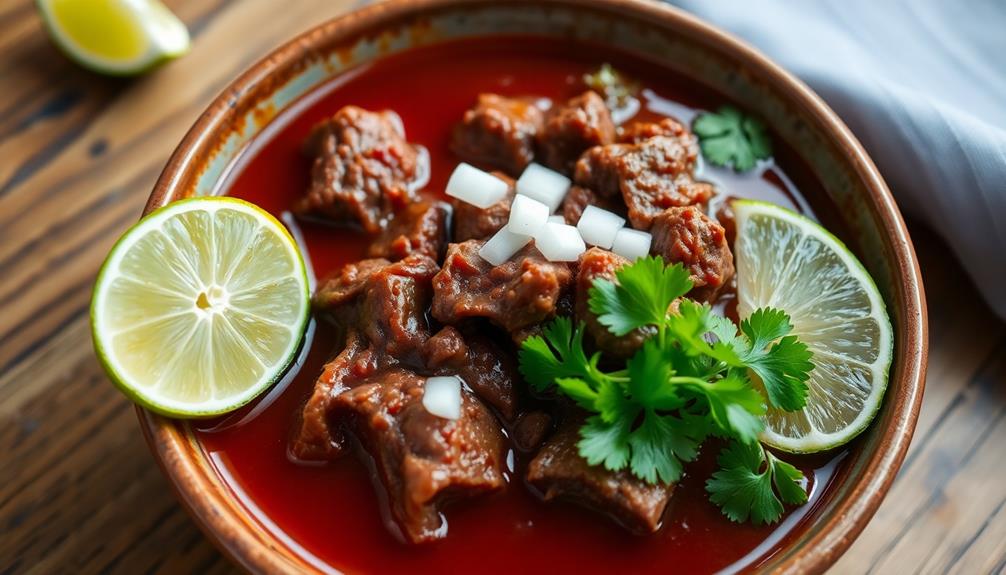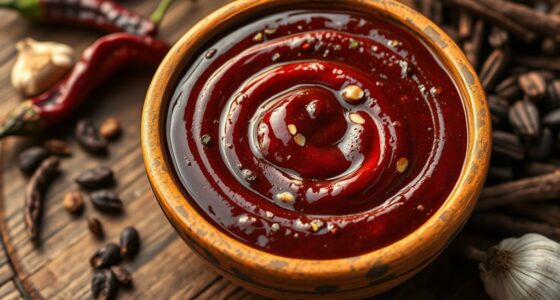Birria, the mouthwatering Mexican stew, has a rich history dating back to colonial times in Jalisco. This savory dish is made from tender meats and spices, creating a flavorful broth that's simply irresistible. Birria is more than just a meal – it's a symbol of Mexican culinary heritage, bringing people together to celebrate and share in the joy of this beloved dish. Whether you enjoy it in tacos, ramen, or the traditional way, the vibrant colors and aromas of birria will transport you to the heart of Mexico's vibrant food culture. Get ready to embark on a delicious journey as you explore the world of birria!
Key Takeaways
- Birria is a traditional Mexican stew originating from Jalisco, known for its savory broth and versatility in ingredients and serving styles.
- The preparation process involves searing, braising, and shredding the meat to achieve a unique depth of flavor.
- Birria is celebrated for its cultural significance, serving as a communal dish that fosters social connections during gatherings.
- The dish has evolved over time, with Spanish settlers introducing new ingredients and inspiring creative interpretations in the culinary scene.
- Birria's visual and sensory appeal, from its vibrant colors to its textural contrast, contribute to its growing popularity worldwide.
History
Originating from the Mexican state of Jalisco, the history of birria can be traced back to the colonial era. In those days, the local indigenous people would slow-cook meat in an underground pit, infusing it with delicious spices and flavors.
As time passed, this traditional dish evolved, with new ingredients and cooking methods being introduced by Spanish settlers. Today, birria has become a beloved staple across Mexico, each region putting its own unique spin on the recipe.
The word "birria" itself is believed to have originated from the Náhuatl language, meaning "a spicy stew." This savory and aromatic dish is often made with tender goat or beef, simmered to perfection in a blend of chili peppers, garlic, and fragrant herbs.
The result is a rich, flavorful broth that perfectly complements the succulent meat, making birria a true delight for the senses.
Recipe
Birria is a traditional Mexican dish that originated in the state of Jalisco. It's a rich, flavorful stew made with tender, slow-cooked meat that's typically served with a side of consomé, or broth, for dipping.
The process of making birria can be time-consuming, but the result is well worth the effort. The complex blend of spices and the slow cooking process create a depth of flavor that's truly unique and satisfying.
Ingredients:
- 3 lbs beef chuck roast, cut into 2-inch cubes
- 1 onion, diced
- 4 garlic cloves, minced
- 3 ancho chiles, stemmed and seeded
- 2 chipotle chiles in adobo sauce, minced
- 1 tbsp ground cumin
- 1 tsp ground coriander
- 1 tsp dried oregano
- 1 tsp ground cinnamon
- 1 tsp salt
- 1/2 tsp black pepper
- 4 cups beef broth
- 2 bay leaves
Cooking Instructions:
In a large pot or Dutch oven, sear the beef cubes over high heat until browned on all sides, about 5 minutes per batch. Remove the beef from the pot and set aside.
In the same pot, sauté the onion and garlic until softened, about 5 minutes. Add the ancho and chipotle chiles, cumin, coriander, oregano, cinnamon, salt, and pepper, and cook for 2-3 minutes to toast the spices.
Pour in the beef broth and add the bay leaves. Return the beef to the pot and bring the mixture to a boil. Reduce the heat to low, cover, and simmer for 2-3 hours, or until the beef is very tender and easily shreds with a fork.
Tips:
For an authentic birria experience, serve the stew with warm corn tortillas, diced onion, fresh cilantro, and a side of the flavorful consomé for dipping.
The longer the birria simmers, the more the flavors will develop and meld together. Additionally, you can experiment with different types of chiles to adjust the heat level to your preference.
Cooking Steps
Sear that meat in a Dutch oven until it's nice and browned.
Then, braise it with all sorts of spices and seasonings to really amp up the flavor.
Once it's cooked through, use two forks to shred the meat into tasty little pieces.
Now, dip those shredded bits right into the delicious broth for an extra burst of yumminess.
Step 1. Sear Meat in Dutch Oven
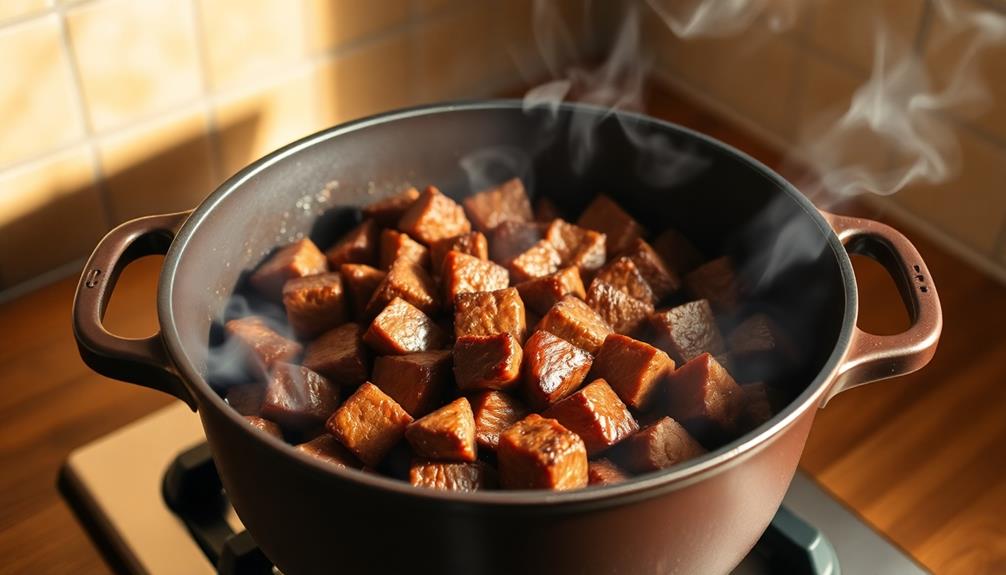
The Dutch oven's heavy-bottomed construction ensures even heating, making it the ideal vessel for searing the beef.
Once the pot is piping hot, you'll want to add a thin layer of oil. When the oil shimmers and sizzles, it's time to carefully lower the beef cubes into the pan.
Listen to the satisfying sear as the meat hits the hot surface! Sear the beef on all sides, turning it with tongs to get an even browning.
This crucial step locks in the savory flavors and gives the birria that mouthwatering caramelized crust. Work in batches if needed to avoid overcrowding the pan.
Be patient and let each piece get nicely browned before flipping. With the beef seared to perfection, you're ready for the next step in creating this incredible Mexican dish.
Get ready for the aromas to fill your kitchen as the birria simmers to tender, juicy perfection.
Step 2. Braise Meat With Spices
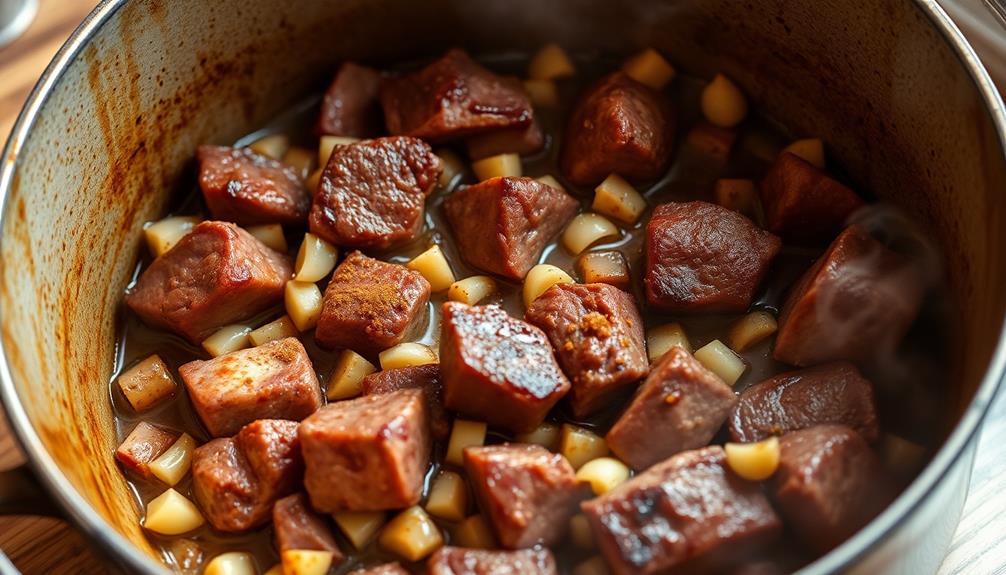
After searing the beef, you'll want to add the aromatic spices. Grab a big handful of cumin, chili powder, and garlic powder. Sprinkle them right over the sizzling meat, then give everything a good stir. The spices will toast up and fill your kitchen with the most mouthwatering aroma!
Next, pour in some beef broth and a splash of apple cider vinegar. The vinegar will help tenderize the meat as it braises.
Cover the Dutch oven with a tight-fitting lid and slide it into the oven. Let the beef slowly cook for about 2 hours, until it's fall-apart tender. Every so often, give the pot a little shake to baste the meat in the flavorful juices.
When the timer goes off, carefully remove the lid – be careful, that steam is hot! Use two forks to shred the beef right in the pot. The meat should practically melt in your mouth. Now you're ready to assemble your birria tacos!
Step 3. Shred Meat Using Forks
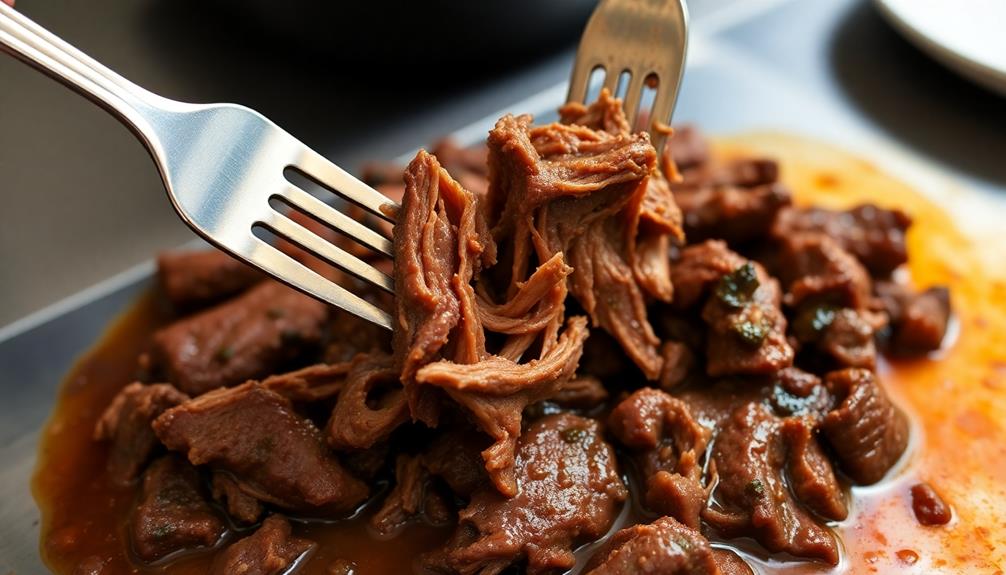
When the timer goes off, carefully remove the lid – be careful, that steam is hot! The tender, fragrant meat is ready to shred.
Grab a couple of sturdy forks and get to work. Gently pull the meat apart, separating it into delightful, stringy strands. The forks glide through the meat, making it easy to shred into the perfect texture.
As you work, the aroma of the warm spices fills the air, making your mouth water in anticipation. Keep shredding until the entire piece of meat has been transformed into a fluffy pile of shredded goodness.
This step is crucial, as the shredded meat will soak up all the rich, complex flavors of the birria broth. Take your time and make sure every last morsel is pulled apart.
With the meat shredded, you're one step closer to enjoying the full, bold taste of this incredible dish.
Step 4. Dip Shredded Meat in Broth
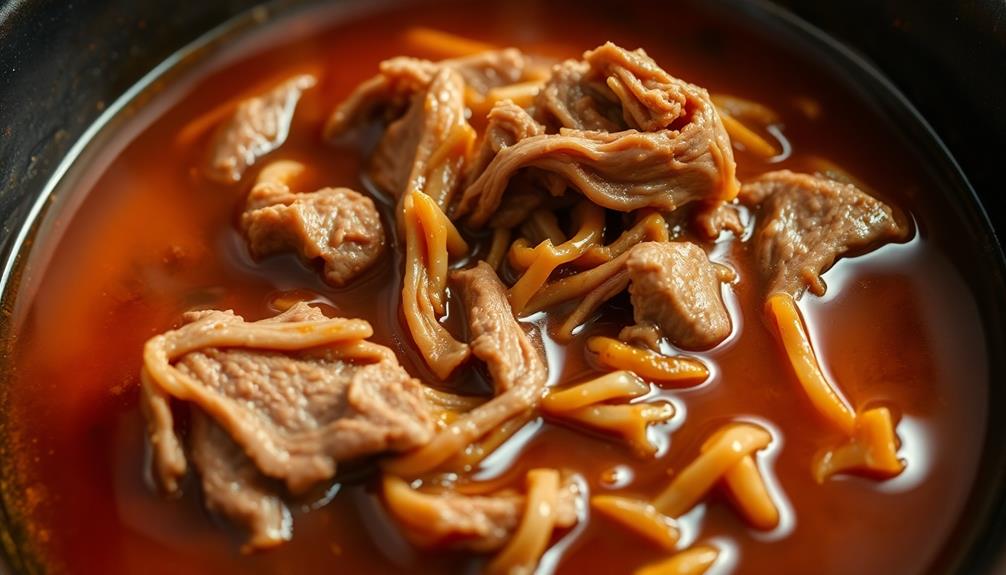
With the meat shredded, it's time to dip it in the rich, aromatic birria broth. Grab a small bowl and ladle in some of the warm, fragrant liquid.
Gently lower the shredded beef into the broth, letting it soak up all the wonderful flavors. The beef will turn a deep, reddish-brown color as it becomes infused with the spices and herbs.
Gently stir the meat, ensuring every piece is coated evenly. The aroma will fill the air, making your mouth water in anticipation. Take a moment to breathe it all in – the earthy cumin, the smoky chiles, the zesty citrus.
Now, it's time to assemble your birria tacos! Scoop a generous portion of the broth-soaked meat onto a warm tortilla.
Top it with your favorite garnishes like chopped onion, cilantro, and a squeeze of lime. Get ready for an explosion of textures and tastes in every bite!
Step 5. Assemble Tacos With Shredded Meat
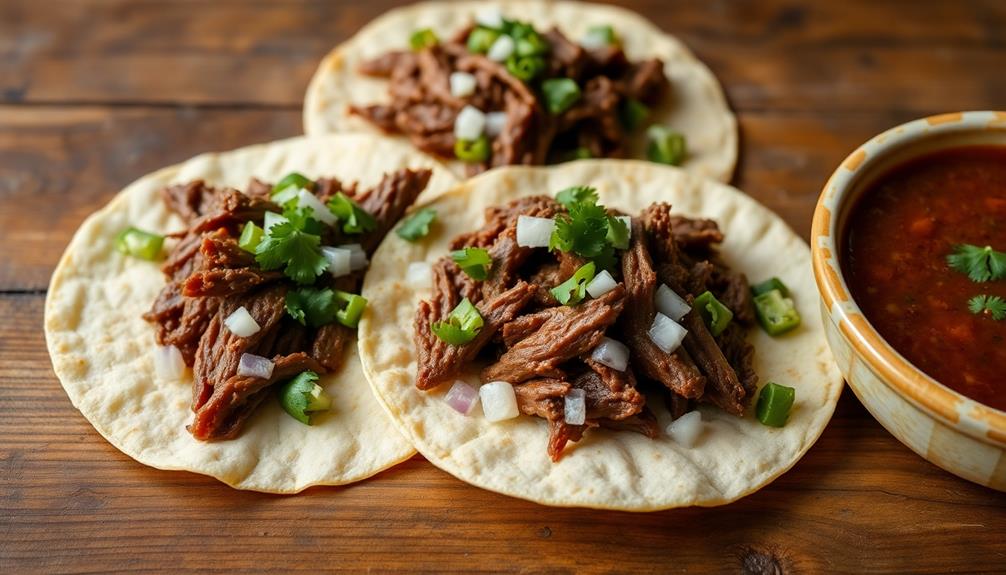
Take a warm tortilla and scoop a generous portion of the broth-soaked shredded beef onto it. The tender, juicy meat will make your mouth water as you add a sprinkle of diced onion and a few leaves of fresh cilantro.
Fold the tortilla in half, creating a delectable taco that's ready to devour.
Now, grab another tortilla and repeat the process, piling on more of that irresistible birria filling. Feel the steam rising as you assemble each taco, the aroma of the spices and savory broth filling the air.
Don't be shy – stack those tacos high, making sure every bite is packed with flavor.
As you take your first crunchy, messy bite, the rich, beefy notes of the birria will dance on your tongue. The onion and cilantro provide a refreshing contrast, while the warm, soft tortilla ties it all together.
Get ready to savor every last morsel of these incredible tacos!
Final Thoughts
Birria, a vibrant and flavorful Mexican dish, has captivated the hearts and taste buds of food enthusiasts worldwide. As you've discovered, the process of assembling the perfect birria tacos is truly an art form, where the shredded meat and savory broth come together in a symphony of flavors.
But the journey doesn't end there! Birria is a versatile dish that can be enjoyed in countless ways, from sipping the rich consommé to exploring creative variations like birria ramen or quesabirria.
The beauty of birria lies in its ability to bring people together, whether it's sharing a steaming plate of tacos with friends or savoring the comforting warmth of the broth on a chilly day.
As you continue your birria adventure, remember to embrace the vibrant colors, the aromatic spices, and the sense of community that this beloved dish embodies. The flavors of birria will undoubtedly leave a lasting impression, inspiring you to explore more of the rich culinary traditions of Mexico.
Frequently Asked Questions
What Is the Origin of the Name "Birria"?
You're curious about the origin of the name "birria", aren't you? It's believed to have roots in the Spanish word "birria," which refers to a spicy, stewed meat dish commonly found in Mexican cuisine.
How Long Does It Take to Prepare Traditional Birria?
Preparing traditional birria takes time, doesn't it? Typically, it can take several hours, from marinating the meat to slowly simmering the stew. The process requires patience, but the rich and flavorful result is well worth the effort.
Can Birria Be Made With Different Types of Meat?
Yes, you can make birria with different types of meat. Traditionally, beef is used, but you can also make it with lamb, goat, or even chicken. The cooking process remains the same, regardless of the meat you choose.
Is Birria a Spicy Dish, and How Can the Heat Be Adjusted?
Is the dish you're referring to typically spicy? You can adjust the heat by using more or less of the chiles and spices in the recipe. Some versions are milder, while others pack a real punch of flavor.
Can Birria Be Frozen and Reheated Without Losing Its Flavor?
You can definitely freeze and reheat birria without losing its flavor. The key is to cool it completely before freezing, then reheat it slowly on the stovetop or in the oven when you're ready to enjoy it again.
